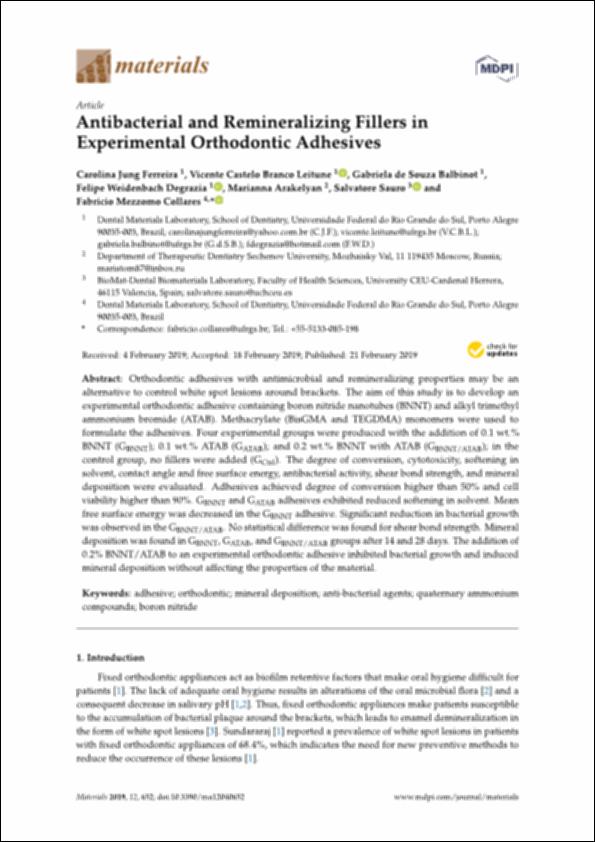Please use this identifier to cite or link to this item:
http://hdl.handle.net/10637/10685Antibacterial and remineralizing fillers in experimental orthodontic adhesives
| Title: | Antibacterial and remineralizing fillers in experimental orthodontic adhesives |
| Authors : | Ferreira, Carolina Jung Leitune, Vicente Castelo Branco Balbinot, Gabriela de Souza Degrazia, Felipe Weidenbach Arakelyan, Marianna Sauro, Salvatore. Mezzomo Collares, Fabricio |
| Keywords: | Ortodoncia.; Germicides.; Adhesivos dentales.; Bactericidas.; Materiales dentales.; Dental materials.; Orthodontics.; Dental adhesives. |
| Publisher: | MDPI |
| Citation: | Ferreira, CJ., Leitune, VCB., Balbinot, GS., Degrazia, FW., Arakelyan, M., Sauro, S. & Mezzomo Collares, F. (2019). Antibacterial and remineralizing fillers in experimental orthodontic adhesives. Materials, vol. 12, n. 4 (21 feb.), art. 652. DOI: https://doi.org/10.3390/ma12040652 |
| Abstract: | Orthodontic adhesives with antimicrobial and remineralizing properties may be an alternative to control white spot lesions around brackets. The aim of this study is to develop an experimental orthodontic adhesive containing boron nitride nanotubes (BNNT) and alkyl trimethyl ammonium bromide (ATAB). Methacrylate (BisGMA and TEGDMA) monomers were used to formulate the adhesives. Four experimental groups were produced with the addition of 0.1 wt.% BNNT (GBNNT); 0.1 wt.% ATAB (GATAB); and 0.2 wt.% BNNT with ATAB (GBNNT/ATAB); in the control group, no fillers were added (GCtrl). The degree of conversion, cytotoxicity, softening in solvent, contact angle and free surface energy, antibacterial activity, shear bond strength, and mineral deposition were evaluated. Adhesives achieved degree of conversion higher than 50% and cell viability higher than 90%. GBNNT and GATAB adhesives exhibited reduced softening in solvent. Mean free surface energy was decreased in the GBNNT adhesive. Significant reduction in bacterial growth was observed in the GBNNT/ATAB. No statistical difference was found for shear bond strength. Mineral deposition was found in GBNNT, GATAB, and GBNNT/ATAB groups after 14 and 28 days. The addition of 0.2% BNNT/ATAB to an experimental orthodontic adhesive inhibited bacterial growth and induced mineral deposition without affecting the properties of the material. |
| Description: | Este artículo se encuentra disponible en la página web de la revista en la siguiente URL: https://www.mdpi.com/1996-1944/12/4/652 Este artículo pertenece al número especial "Orthodontic Materials and Adhesive Interfaces". |
| URI: | http://hdl.handle.net/10637/10685 |
| Rights : | http://creativecommons.org/licenses/by/4.0/deed.es |
| ISSN: | 1996-1944 |
| Issue Date: | 21-Feb-2019 |
| Center : | Universidad Cardenal Herrera-CEU |
| Appears in Collections: | Dpto. Odontología |
Items in DSpace are protected by copyright, with all rights reserved, unless otherwise indicated.


